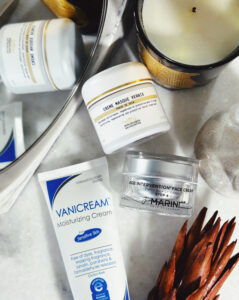
By now y’all know how much I adore moisturizers–I never used to be that way. I used to just have a few moisturizers I used and didn’t really care that much about this category of skincare. Honestly, I used to find moisturizers to be the most boring part of a skincare line. I was all about the actives and serums. I’ve come to really appreciate a good moisturizer not only because it’s so essential for my dry skin health, also because a moisturizer is such an essential part of a good skincare routine. You’ve heard cleanse, moisturize, SPF as the only three essential steps–which is true. However, I do quite enjoy the fluff stages like serums and mists in between as well. Moisturizers are not all created the same. They can be basic or fancy, be cheap or pricey, be thin or thick, be lipid rich or oil free. They can moisturize, or they can moisturize plus deliver active ingredients. They have differing levels of longevity on the skin–meaning some can last all night, some only last two hours before they feel like they’re almost gone. Moisturizers are easily one of the most personal categories of skincare. Just because I like it doesn’t mean everyone will, others may like ones that I don’t. I may think one is light, while others may think it’s too heavy.
Moisturizers are made with a combination of occlusives, humectants and emollients. Ingredients can be both a humectant and an emollient. Emollients and occlusives are also really kinda the same thing–though there are some that are heavier than others, so they work better as an ‘occlusive’ if you’re looking for better longevity, reducing TEWL a lot, or have really dry skin. I wouldn’t get hung up on what type the ingredient is, more so knowing it’s a combination of these ingredients that ultimately make up a moisturizer. There are so many different combinations of these ingredients you can mix = why there’s so many different moisturizers. You cannot judge a moisturizer by the inci (ingredient) list. You have to try it to know. There are many that seem great based on the inci list–then I try them and they’re so disappointing for my super dry skin. There are also many moisturizers I get thinking there’s no way this will be enough for me and bam–it’s fantastic.
- Humectants are ingredients that attract, bind and retain water like glycerin, hyaluronic acid, aloe, plant sugars (polysaccharides), sugar alcohols, collagen, sodium PCA, Aquaxyl, Betaine, AHAs, honey, seaweed, urea, peptides, amino acids, panthenol–anything that hydrates the skin.
- Emollients are things that soften and moisturize the skin like ceramides, polymers, silicones, caprylic/capric triglyceride, plant oils, lipids, butters, fatty acids/fatty alcohols, phospholipids and sterols (like cholesterol).
- Occlusives are things that help reduce TEWL (Trans Epidermal Water Loss) like silicones, hydrocarbons (petrolatum, paraffin, mineral oil), waxes, lanolin, sterols, butters and polymers.
I don’t personally consider oils an occlusive, as they are only very minimally occlusive for my skin. They can be ‘occlusive’ for more oily types but for dry or really dry skin–oils just aren’t that occlusive in the long run. Always remember formulation of the ingredients in a moisturizer is key–not the ingredients themselves. Again, you always have to try a moisturizer out to really know how it performs, especially in the longevity category. I’ve tried a ton of moisturizers over the last few years searching for the best ones for really dry skin that last all night. I’ve tried almost every cream recommended for dry skin by magazine articles, Dermatologists online, my followers or other influencer suggestions. I’ve tried budget brands, Indie brands, European drugstore brands, American drugstore brands, K Beauty, luxury, Sephora and Department store brands. I still have more to go for sure; but I don’t want to be wasteful so I wait until I get rid of some current moisturizers or use them up before I buy more–plus I only have so much money to spend.
Quite often I’m really disappointed by the majority of moisturizers marketed for dry, mature skin. Most just aren’t enough for my skin, or they seem OK at first only to disappear 2 hours later leaving me dry and tight. Some make great day creams, yet don’t work as night creams. I’m pretty convinced that many who make these creams don’t have really dry skin nor fully understand it. As background I’m 45, maybe a year from Menopause and finishing my Perimenopause journey. I have chronic extremely dry skin. Like dry as the Sahara Desert. Just as there are different levels of oily skin–there are different levels of dry skin. There’s chronic versus temporary or situational. You can be mildly dry, moderate or very dry. It’s a tier–someone with situational mild dry skin is going to feel a whole different way about a moisturizer for ‘dry skin’ than someone with chronic really dry skin will.
Many moisturizers I try on the market that say geared towards ‘dry skin’ are really more for this mild dry level or even combo skin. I started wondering if anyone actually formulates for people like me with chronic really dry skin in mind. Or if brands even care. Is there even a market for it? I thought about the clinical studies brands present for these dry skin creams saying it was so good for my dry skin and left me moisturized all night long. It left me wondering were these people really dry to begin with? Did they even know if they truly had dry skin? How dry were they? Had they not been using a skincare routine or good moisturizers before becoming part of this brand trial? This whole idea actually threw me on a quest to find all the moisturizers I could that satisfied really dry skin at night. Day creams are way easier to find.
I talk about dry skin a lot on my blog and on Instagram. I want to go over dry skin basics again. Dry skin can be chronic versus acute (temporary or situational). Chronic conditions continue past a year. Chronic dry skin is often genetic (think Northern European heritage, familial genetic mutations). Your skin can change from combo in youth to dry during adulthood due to hormonal transitions or other medical reasons. I’ve been thinking that maybe inherited dry skin can start us off dry while we’re kids (perhaps with eczema like me), then we end up seeming more combo and oily related to hormonal peaks during puberty in adolescence/young adulthood. You may end up even having a good bout of oily skin as an older adult during hormonal changes commonly called hormonal acne (I got it in my 30s before going through Perimenopause). If you take birth control as well during those younger years–that can make you produce more oil making you seem more combo versus dry. Perhaps genetically we were dry to begin with–but hormones made us temporarily combo or more oily in youth? Interesting thought.
Hormones changes play such a huge role. You get that dip of estrogen and other hormones during Perimenopause causing the skin to get drier. Men also have hormone changes like drops in Testosterone starting in mid-adulthood that can cause them to become drier with age. Granted men’s hormones decline slower and more gradually than women, which is why we have this sudden dip and change to dry skin quickly in our mid-adulthood. It takes men longer to feel this decline and change. Some may go through Perimenopause and even Menopause and not get dry. You can still be oily and combo post Menopause–even have breakouts. Menopause does not always mean you’ll get dry skin. Medications can also play a role in dry skin. Some medications cause skin dryness like statins, beta-blockers, diuretics, chemo, antihistamines, some anti-psychotics or anti-depressants, acne medications and retinoids. If these medications are used temporarily then your skin dryness will likely be acute or temporary. It should resolve if the medication is stopped. If that medication is lifelong for a medical condition then your dry skin as a side effect will eventually become chronic. It’s never cut and dry, there’s so many variables.
Some of the characteristics of chronically dry skin are: Dryness is consistent over a year (you don’t go oily then dry, oily then dry. You stay dry); You don’t change during seasonal changes like summer meaning you never get oily in the t-zone; You never get oily–ever; You’re dry year round with no variation other than summer is dry and winter is worse dry; You’re dry all over your body plus your face. Everyone has dry areas like hands/elbows/feet–this means dryness on your arms, chest, back, belly, legs; Your skin eats lipids up when applied. If you’re chronically dry nothing is going to change it whether it be season, climate, or no matter how you change your routine. You can layer ten products, plus a balm, moisturizer and occlusive–yet still end up dry in the morning. That’s really dry, chronic dry skin. Dry skin simply doesn’t produce as much sebum as other skin types. You can put a facial oil or balm on, then it fully disappears into your skin under two hours later. Body oils don’t work on you–they make you feel dry an hour later. You may also be to the point where you no longer break out at all. Minus a rare 1-2x a year incident. Dry skin tends to have less visible pores and you don’t get clogged pores or congestion often like more oily skin–but you get wrinkles more easily than someone who is more oily. Dry skin also has inherent barrier issues due to it’s nature. You have more problems maintaining a healthy barrier than other more oily skin types.
Acute or temporary dry skin is situational. It could be from a routine that was maybe too harsh or you disrupted your skin barrier by using too many actives. Pregnancy can cause temporary dry skin. I went oily, then super dry, plus reactive but that’s a whole other story. The hormones will change after the baby comes and you’ll go back to normal–hopefully. Current or chronic retinoid can cause dryness as a side effect, if you stop the retinoid you’ll loose the side effect. Some may only get the side effect in the beginning while getting used to a retinoid and it may not become chronic dryness due to the medication. Users of acne medication may get dryness as a side effect. It could go away and be temporary or it could last longer than a year if you continue it. The season may have gone to winter causing temporary dryness due to the indoor heat. Maybe you had a nice vacation and were exposed to UV or winter conditions while skiing–those can cause temporary dry skin. A new medication you had to take for a week might have caused dry skin. When I used to use ascorbic acid daily the constant low pH on my skin gave me a slightly dry side effect as well.
Situational dry skin subsides when the aggravating factor is removed from the mix. That’s the difference between chronic and temporary dry skin. They’re both technically in a current dry skin state–but they behave differently. I’ve been both types. When I was combo before Perimenopause I had temporary dryness from you name it–retinoid use, harsh routines where I screwed up my barrier and stripped my skin, pregnancy, seasonal changes etc. During that dry skin state (while having combo skin as a baseline) I’d use an extra humectant, remove the harsh actives, add an extra creamy product in and use a slightly heavier moisturizer. Worked every time. In this temporary state I never felt dry after using moisturizer like it wasn’t enough. Ironically there were even times when I tried a barrier cream, that I love now, and it felt like it was too heavy even (OBAGI Luxe). There were products that felt too occlusive and heavy even in that temporary dry state. I even broke out from some of those heavy creams I tried during a temporary dry state.
I bring this up because there is a difference between a temporary dry skin state on someone who has a baseline that’s not dry, versus someone who has chronically dry skin at baseline. You’re dry in that temporary state, but you haven’t lost all your oil production yet. These creams for dry skin work for you well. These midweight barrier creams are great. Those same creams for that chronic dry skinned person are likely not enough. They need more. More lipids, more longevity, more occlusion. They’re not going to break out from a heavy product. They will feel dry hours after applying the same moisturizer that worked for a combo person who screwed up their barrier with retinoids or whatever the reason. The moisturizers you pick can be lighter when you’re in a temporary dry phase. Chronically dry skin needs lipids. Oils. Once you hit chronic you want and need all the oils and lipids. You can’t go without it. That’s how you know. Dry skin still needs humectants so don’t think I’m only saying they need lipids. But lipids are the key to helping soothe chronically dry skin. That’s why I look for lipid rich moisturizers not just with fatty acids but oils and butters. I can even put a facial oil on below a lipid rich cream and still not break out. This level of dry skin is different than what many think it’s like. You truly have to go through it to fully understand the level of it.
One of the main reasons I really started to get into moisturizers more a few years back was Perimenopause. I haven’t finished the post with my journey yet (hopefully this year I’ll finish it). Essentially as my hormones changed–my skin changed dramatically. The dryness I started experiencing was like no other. Old creams no longer worked for me. I was desperate to find any creams that would satisfy my now really dry skin. The moisturizers in this post are going to be geared towards really dry skin that’s sensitive. I have rosacea and while there are some creams on the market that are heavy and nice for dry skin, they have essential oils or strong fragrance so I excluded them. Mostly because I can’t use them often for that reason and this post is about my holy grails that I actually use all the time. My ride or die night moisturizers. I’ll start with the heaviest three of the bunch.

Biologique Recherche Creme Mask Vernix is one of the creams I’ve been using the longest. I totally got into it before I became as dry as I am now. It is still just as good now. I used to only be able to use it in the winter, but now I can use it year round. It’s glossy, thick and glorious in texture. It forms this thick, slightly waxy feeling coating on the skin. That’s what makes this so great. It feels odd at first but it’s like this coating that lasts all night long. It plays well with balms, oils and occlusives like Vaseline or Aquaphor. The name came from vernix on a newborn which is basically a waxy coating that protects the skin while they’re in utero. I could care less what they call it as it’s utterly fantastic. I go through at least a full jar every year, if not more.
The scent reminds me of bananas a little in the beginning, but then it turns more into a musty scent as the cream ages. It’s not one you leave sitting around without using it–use it up. Vernix has lipids, glycols, ceramides, cholesterol and lanolin oil. The lanolin oil is what helps give this it’s heavy long lasting feel. I know it’s getting reformulated to be vegan which means the amniotic fluid, placental protein and embryo extract along with the lanolin oil will go away. I have not tried the reformulation. I’m kind of scared to try it honestly as this has been such a holy grail for me. This is the most expensive of the creams I listed in this post running $209 a jar. Review HERE.
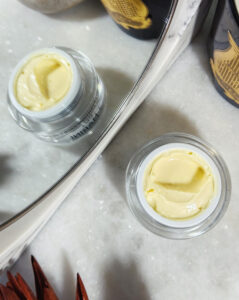
Jan Marini Age Intervention Face Cream is one of the most glorious creams ever. It’s slightly airy in texture plus lipid rich making it great for dry skin. Being lipid rich is nice, but not every lipid rich cream lasts. My dry skin tends to eat those types of creams up faster ruining their longevity. That is not the case with this formula. It lasts great and leaves my skin super soft in the morning. This has oils, shea butter, MSM, antioxidants, plankton and Interferon Alpha 2 (Jan Marini patent). If you’re looking for a lipid rich cream for dry skin–look no further. This one’s for you. I would not recommend this for combo to oily skin due to the lipid content. This is great for dry and mature skin. I don’t find it greasy or heavy on me, but those who don’t need as many lipids might. I suggest the Transformation Cream for combo to more oily skin. Age Intervention runs $125 a jar but there’s often sales where you can get 25-30% off and stock up.
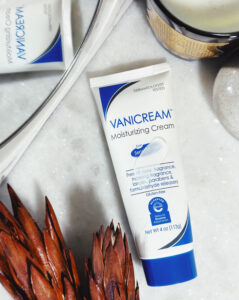
Vanicream Moisturizing Cream is the cheapest night cream I can recommend for dry skin. It’s super affordable. It’s technically a body cream–but it’s really such a fabulous face moisturizer. The texture is thick looking but it’s not super heavy nor greasy feeling. It’s also not the most elegantly textured face cream if you like typical smooth and glossy creams. I don’t care because it’s really good at reducing TEWL and lasts the night. I can use this year round as it’s not lipid rich. Actually, it has no fatty acids, oils or butters. Just petrolatum with emollients. Use a facial oil underneath if you’re dry to get your lipids in. I’ve also used Vanicream over a face balm as a more occlusive later–I love this combo. You can even use it over another moisturizer that’s a bit light if you want a more occlusive, longer lasting seal. Combo skin should be able to use this just fine because it’s not full of lipids (or any lipids for that matter). I’ve been through multiple small size tubes. You can buy the small size for $7 or the large jar for $14. It’s easily the longest lasting moisturizer in the under $20 price range period. You can use it as an eye cream, hand cream, body cream, layer it–this has a multitude of uses. It’s a total gem.
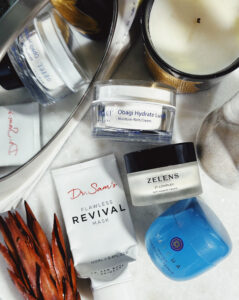
The creams I move onto now are a little lighter overall than the three I just discussed. I apply two layers of these creams to get the desired level of product I need. I suggest two coats for dry skin. I usually follow these with an occlusive of some sort in the winter, I don’t need to in the summer. You can also use a little coat of Vanicream over if you wish–that works as well. What’s the point in listing creams that may not always be OK on their own and need an occlusive over? Because there’s only so many creams that don’t need an occlusive on top if you’re really dry. It’s a low selection. These creams all have great textures–they just need a little help on occasion. I can live with that in order to have more variety. Honestly, in the deep of winter I can use Vaseline over Vernix, Jan Marini and Vanicream. With really dry skin there’s never a clear cut answer for how much you need or can layer.
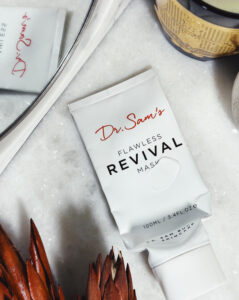
Dr. Sam’s Flawless Revival Mask is technically a mask–wash off or leave on. It’s better as a leave on moisturizer in my full opinion. You can tell my tube is almost empty and I’m squeezing the last bits out. I adore this moisturizer. It’s glossy with a medium weight texture. It’s fairly simple with shea butter, squalane, a few humectants and emollients. It’s a great overnight cream. Two layers and you’re good. The size is large and it takes a long time to go through a tube. I use it really often and it’s taken forever to almost empty this tube. This one runs $43 for a 100ml tube which is twice the size of the other 50ml creams. I do need to try the new Intense Moisturizer which is supposed to be amazing. I have not gotten to try it yet.

TATCHA Indigo Overnight Repair is a delicious glossy serum in cream for soothing the skin. It has a glossy, stiff gel cream meets cream texture. This has mondo grass and Japanese Indigo extract to soothe, combined with humectants, ceramides, silicones and phytosterols. It has linoleic acid but no other oils, butters or lipids. It’s very lipid light and kind of like a gel cream on steroids. It’s a fabulous product, just make sure you use lipids with it like a facial oil under or balm over if you’re really dry and not just situationally dry from retinoids. I tend to reach for this one more in the summer versus the winter. I usually need a little more in the winter than this can give me. This one runs $92 for a jar. With an occlusive or Vanicream over it this is enough for my skin. It’s a really lovely texture.
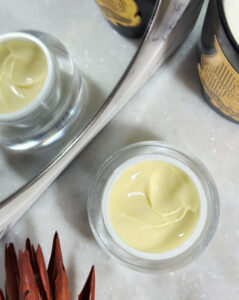
OBAGI Hydrate Luxe cream is a bouncy textured, lipid rich, medium weight cream. It has silicones, butters, oils, humectants and emollients. It’s less lipid heavy than Jan Marini but it’s more than other moisturizers I listed so far. It has a more satin leaning finish on the skin so it’s not too heavy feeling. I tend to use Jan Marini in the winter and this more in the summer. Sometimes I have to cover this with an occlusive–more so in the winter if I use it. Honestly, until tonight I didn’t even realize it had fragrance in it. You can’t even tell. Must be to mask the natural ingredients. It smells like a moisturizer made of natural ingredients. I find the scent non-irritating to my nose and skin. You can’t tell on this one. This cream runs $78 for a jar. I’m on number three at this point. I would 100% pick Jan Marini over this one if I had to pick only one. This was also a cream I tried years back when I was still combo but situationally dry–I thought it was too heavy and gave it to my mother. Now I love it and it’s not too rich at all. Funny how the tides change.

Zelens 3t Complex is a cream I have been using for a long time. At least five years. It recently had a makeover. It used to be a bit more creamy and less heavy that it is now. The texture now is a glossy, stiff gel cream meets cream similar to TATCHA. The texture almost reminds me of the old Stem Complex if you remember that one. This cream has ursolic acid which is great for barrier repair, botanical extracts, an algae complex and blend of 7 oils. It’s also got emollients, humectants, occlusives, silanols (stimulate collagen and enhance cellular communication). It doesn’t have butters but it’s more heavy on the silicones/polymers so keep that in mind if you don’t like that as much. I love this at night in the summer and honestly it can be a good day cream too in the winter. If I use two layers with an occlusive or balm over it’s fab. This just gives such a nice glow to the skin and plumps it up. The price of this cream can totally change depending where you buy it from. Typically $85-140 is the difference. Any US retailer will be the most expensive. Buy this from a UK or European site. Selfridges, Look Fantastic UK, Harrods, Cloud 10 has become my favorite. It tends to go on sale there a lot so that’s the site I linked. Review of the original version HERE.
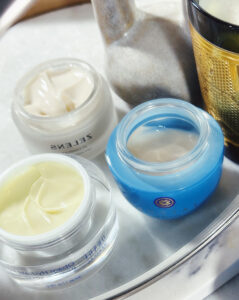
The Ordinary Natural Moisturizing Factors + PhytoCeramides is a great budget friendly option in the medium weight, glossy, gel cream meets cream style of moisturizer. Like a stiff gel cream meets a cream. It has humectants, emollients, fatty acids, amino acids, linoleic and oleic acids plus vegetable oil, natural sugars and urea. You get a 100ml tube for $22.50 which is amazing price wise. It’s like the others and I need two layers, during the winter I need more on top like a balm or occlusive, while in the summer I’m fine with just this. I can’t use it every night as urea can give me irritation around the nasal ayla area due to it’s mild exfoliating properties. If you want a cream to use once a week if you’re more sensitive, or if you’re dry and have no sensitivities to exfoliation then this one is great.
Final Thoughts
In the long run if you have really dry skin I would recommend the top three moisturizers: Biologique Recherche, Jan Marini, or Vanicream. They are tried and true tested on my dry AF skin and repurchased many times. The other ones are great, they may need some tweaking with occlusives depending on the season or how dry you are. I tend to look for creams containing butters, oils, fatty acids, dimethicone, petrolatum, polymers/emollients, cholesterol/ceramides, sterols and humectants to some degree (I can always apply extra under so it’s not a game changer for me). If a cream only has a butter, oils, fatty acids/ceramides, humectants and a wax it’s rarely enough for me. This tends to be true of the clean beauty creams more so than the regular world. Waxes don’t make up for dimethicone/silicones or other synthetic emollients/occlusives. They just don’t cut it in the long run for longevity.
In general it was pretty disappointing how many drugstore brands had no creams really worthy of dry skin for night time. They worked for day time, but night time they all lacked a hefty feel and longevity. Indie brands have really been killing it more in this area. Once we move onto day creams then there’s more choices overall and in the drugstore category. I hope that in the future brands and cosmetic formulators can keep in mind this special population of chronic very dry skinned people that don’t have that many options on the market for night creams that really last.
Shall I do day creams next?
Some of the moisturizers that almost made the cut: African Botanics Fleurs D’Afrique, (Glorious cushiony cream that oddly lasts all night long for a clean beauty cream. It’s the only one to do so for me ever. The jasmine and chamomile essential oils are the only reason this one wasn’t in the list), La Mer Creme de La Mer Original (mineral oil is great, however the eucalyptus essential oil and lime extract are why this one isn’t in here), Medik8 Advanced Night Ceramide Cream (great texture, the rosemary/lavender/orange peel/patchouli/vetiver essential oils are why this isn’t here. One day I wish for a essential oil free version, it’s fab otherwise), Augustinus Bader The Rich Cream (lipid rich and nice, but doesn’t last that long for me. Could use a silicone or petrolatum then it would be great).
Creams that magazine articles, Derms and influencers recommend that I’ve tried and don’t make the cut: CeraVe Moisturizing Cream (for the love of God can we please stop recommending this for dry skin in every article for dry skin online? It might work on the body but it is not a face cream. It’s so light. I’m dry 2 hours later), Olay Ultra Rich/Collagen Peptide (these were both so light I was surprised. Neither was really even a day cream for me. I gave them away and glad I bought minis), SkinCeuticals Triple Lipid Restore (why this is this most touted dry skin moisturizer second to CeraVe I have no idea. It has silicones and polymers, sunflower seed unsaponifiables–which are lighter than oils, no butters, plus lavender/rosemary/peppermint essential oils and T-Butyl alcohol which is a drying alcohol. They list it as great for dry, combo, normal, oily and sensitive skin–It’s great for everyone! Rarely true. Save your money), Drunk Elephant Lala (has ceramides and oils but it lacks the longevity factor by having no silicones or occlusives), Kate Somerville DeliKate Recovery Cream (full of lipids, shea butter, ceramides and humectants. However, it lacks the things that give it longevity. I’m dry a few hours later after applying), First Aid Beauty Ultra Repair Cream (it’s thick, has shea butter, glycerin and some emollients but lacks longevity).
*Some have been PR in the past, but I have repurchased ever one of these multiple times over.